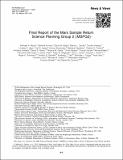Final Report of the Mars Sample Return Science Planning Group 2 (MSPG2)
Author(s)
Summons, Roger
DownloadPublished version (1.794Mb)
Publisher with Creative Commons License
Publisher with Creative Commons License
Creative Commons Attribution
Terms of use
Metadata
Show full item recordAbstract
The Mars Sample Return (MSR) Campaign must meet a series of scientific and technical achievements to be successful. While the respective engineering responsibilities to retrieve the samples have been formalized through a Memorandum of Understanding between ESA and NASA, the roles and responsibilities of the scientific elements have yet to be fully defined. In April 2020, ESA and NASA jointly chartered the MSR Science Planning Group 2 (MSPG2) to build upon previous planning efforts in defining 1) an end-to-end MSR Science Program and 2) needed functionalities and design requirements for an MSR Sample Receiving Facility (SRF). The challenges for the first samples brought from another planet include not only maintaining and providing samples in pristine condition for study, but also maintaining biological containment until the samples meet sample safety criteria for distribution outside of biocontainment. The MSPG2 produced six reports outlining 66 findings. Abbreviated versions of the five additional high-level MSPG2 summary findings are: Summary-1. A long-term NASA/ESA MSR Science Program, along with the necessary funding and human resources, will be required to accomplish the end-to-end scientific objectives of MSR. Summary-2. MSR curation would need to be done concurrently with Biosafety Level-4 containment. This would lead to complex first-of-a-kind curation implementations and require further technology development. Summary-3. Most aspects of MSR sample science could, and should, be performed on samples deemed safe in laboratories outside of the SRF. However, other aspects of MSR sample science are both time-sensitive and sterilization-sensitive and would need to be carried out in the SRF. Summary-4. To meet the unique science, curation, and planetary protection needs of MSR, substantial analytical and sample management capabilities would be required in an SRF. Summary-5. Because of the long lead-time for SRF design, construction, and certification, it is important that preparations begin immediately, even if there is delay in the return of samples.
Date issued
2022Department
Massachusetts Institute of Technology. Department of Earth, Atmospheric, and Planetary SciencesJournal
Astrobiology
Publisher
Mary Ann Liebert Inc
Citation
Summons, Roger. 2022. "Final Report of the Mars Sample Return Science Planning Group 2 (MSPG2)." Astrobiology, 22 (S1).
Version: Final published version